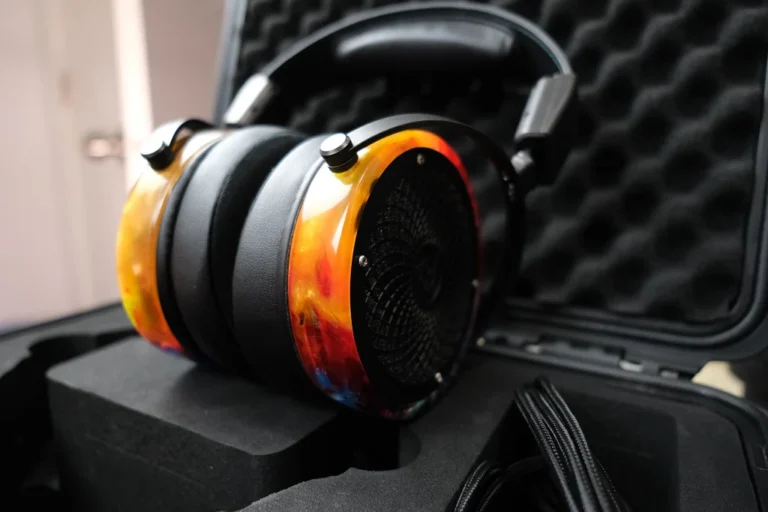iFi Audio Neo iDSD 2 – Full Review

iFi Audio Neo iDSD 2 – Introduction
Greetings all,
Here we examine the Neo iDSD 2, iFi’s relatively new DAC/Amp hybrid device. I was curious to hear how the second Neo iDSD compared to the first since I evaluated the first one a few years ago and wanted to see what changes had been made. The Neo 2 will be the unit’s name throughout this evaluation.
Visually, the Neo 2 is very similar to the Neo 1, although there are several significant modifications between the two. The improved display is a step up from the original model, and the fact that it can be used either horizontally or vertically makes it ideal for desks with limited space. A much stronger headphone amplifier component is the most noticeable modification for the Neo 2. Given the striking similarity between the two amplifier sections—in terms of both output power and sound quality—I can’t help but assume that they are closely connected. From the balanced output (4.4mm), you can see that the power is 5551mw at 32 ohms peak and 2,832mw at 32 ohms RMS, same like with all of iFi’s other devices. The Neo 2 has aptX lossless Bluetooth, 3D sound, and iFi Xbass—which are now dubbed XSpace and Xbass 2—among other features. There are full-size XLR and RCA outputs on the back of the device. A 3.5mm analogue input is available for use with the amplifier alone, along with SPDIF optical and SPDIF coaxial, USB, BNC clock sync, and DC 9V power inputs. A few more buttons than on the Neo 1 let you control gain, Xbass 2, XSpace, and Bluetooth functions on the front of the device. The 4.4 mm and 6.35 mm headphone outputs are also available.
This device has been through its paces in my testing lab, serving as an amplifier for headphones, a digital audio converter, and a hybrid device. After discussing the results in each area, I will divide the material into three parts.

I’ve put this device through its paces in its many guises, including headphone amplifier, digital audio converter, and DAC/amp hybrid. After discussing the results in each area, I will divide the material into three parts.
DAC
If used in isolation, the Neo IDSD excels as a digital audio converter. The Neo 2 is an improvement over previous iFi units, such as the ZenDAC, although it lacks the tube section and other capabilities seen in the Pro iDSD. The Neo 2 sounds significantly warmer in the low midrange when used alone as a DAC, but it has excellent clarity over the whole frequency range. I wouldn’t say the treble is particularly bright or has any unpleasant spikes, but it does have a little shimmer to it. Among the many benefits of the Neo 2 DAC is its dual functionality as a preamp and DAC with independent volume controls. Being able to go from being a DAC/pre into a standalone power amplifier gives you a little more leeway in terms of the unit’s potential uses.
As a pure DAC, the overall detail levels are up to par with, and even slightly above, what one would anticipate from a device in this price range. When comparing the Neo 2 to the Neo 1, both are excellent digital audio controllers. However, the Neo series—and the Neo 2 in particular, with its upgraded head amp section—does a better job of convincing me of its usefulness as a DAC/Amp combo unit. Typical of iFi DACs, the Neo 2’s DAC section offers four filter options: Standard, Bit Perfect, Minimum, and GTO. The Gibbs Transient-Optimised filter (GTO) is my favorite.
This filter has been my go-to among iFi’s offerings ever since I heard it on the original Pro iDSD. It appears to strike the optimal balance among the available options and aids in maintaining a distinct and sharp leading edge for each note, making the overall sound somewhat more refined and detailed. But I think you should test out each filter until you find the one that suits your ears the best.
Amp
The Neo 2 is very comparable to the iDSD Diablo 2, a separate amplifier, that I previously evaluated. Despite my general distaste for that unit, it had no bearing on the Diablo 2’s audio performance; thus, I’m pleased to find that the Neo 2 employs what appears to be a very comparable headamp section. Its processing power dwarfs that of the Neo 1. The LCD-5’s unusually low impedance of 14 ohms caused me to encounter the current protection of the Diablo 2 from the 4.4mm output when I was using it in conjunction with the Diablo 2. I believe this might be related to the fact that it is powered by a 9v wallwart instead of a 5v wallwart or battery, since it never occurred with the Neo 2 on the 4.4mm output. The treble of the Neo 2 headamp section is extremely bright, but else the presentation is extremely neutral. Its impact, drive, and attention to detail are all top-notch. In comparison to the Neo 1’s headamp part, I found the amplifier section to be marginally more detailed. The varying gain levels are another important consideration. When using sensitive IEMs, you can use iFi’s ieMatch at -12 dB. Other than that, there are the standard gain settings of 0, 9, and 16 dB. These modes are referred to as Normal, Turbo, and Nitro on the Neo 2. My hope is that iFi will return to the regular, high, and turbo naming rules they used in the Diablo 2 assessment and standardize their gain name system as well. “Nitro,” formerly known as Turbo, is 18 dB on the Diablo 2, but 16 dB on the Neo 2, so it may all get a little confusing. With most headphones on the market, the Neo 2’s headamp section should be more than enough; but, if you’re using a particularly powerful model, such as the HE6 or Susvara, you may find that it struggles to handle the volume. Those aren’t really typical Neo 2 use cases, but with most other headphones, you should have no problems with volume or gain whatsoever. I could totally picture someone utilizing the Neo 2 as their sole headphone source, particularly if they’re short on desk space, because the amplifier section delivers quite strong sound.
DAC/Amp
Here is where I think the Neo 2 excels, myself. The combination of the somewhat warm DAC part and the extremely neutral, nearly bright amplifier section results in an aesthetically beautiful, well-balanced frequency response. The bottom end is slightly warmer, and there is a hint of sparkle in the highs. The sound signature is laid-back and soothing, making it a breeze to listen to. While some settings can be tedious and too analytical, I never felt that way about this one. The technological performance and degree of detail are commensurate with a device in this price range, and the unit also has all the usual features found in iFi products, which contribute to their usefulness as Swiss army knives. This, along with the Neo 2’s significantly stronger headamp section compared to the Neo 1, makes this device capable of almost anything, and it does it well!

Build Quality
The build quality of the Neo 2 is pretty much exactly the same as the Neo 1. A metal shell that feels well put together. I had zero problems over my time with the unit, and it doesn’t feel flimsy or like it will break at any moment. I really do like the ability to use it either lying horizontally or vertically, and I think that vertical use will be especially helpful for those who have limited desktop real estate available.
Settings/Bluetooth
Although I prefer using DACs and amplifiers via wires, the Neo 2 does include aptX Lossless Bluetooth. After giving it a go for a week, I felt like it was a good fit. The process of pairing your devices was simple and straightforward, therefore I had no issues with it. In addition, the Bluetooth option had very high sound quality; nevertheless, I did perceive a slight change in volume between the wired and wireless connections. I wouldn’t be surprised if that turned out to be true; I’m just curious. Most people will have a strong opinion on this, and some may find that the convenience of not having to deal with cords and other unnecessary noise is more important than any potential improvement in sound quality. You should give it a go and let us know what you think of the feature. A few distinct options are available in the XBass 2 feature’s settings. For individuals who prefer a bass response that isn’t completely neutral, there’s Xbass, which is essentially a bass boost. Xbass Presence is present, amplifying the high and midrange frequencies. If used excessively, it can make the music seem shouty, although it also helps snare drums sound more slam and vocalists sound more prominent. I don’t believe this feature is really cool, but I bet some people will adore it. You should give it a go and see what you think. Xbass + Presence, on the other hand, activates both modes. On the Neo2, you’ll find iFi’s 3D mode, XSpace. Recordings that are hard-panned or older mono recordings can benefit from this type of crossfeed. My own opinion is that it does more harm than good when applied to contemporary recordings; nonetheless, I am aware that this variation on crossfeed is well-received by others, so I would suggest giving it a go and seeing what you think.

Conclusion
Now, I wasn’t exactly gushing about the iDSD Diablo 2 in my review. Personally, I think the Neo 2 is the superior piece of gear. Although I did note in that review that the Diablo 2’s sound was subpar, that was not the case. At list price, it seemed excessive, and it wasn’t really an upgrade over its predecessor. The good news is that the Neo 2 eliminates all of those worries.
The Neo 2’s $899USD MSRP isn’t exactly a steal, but it’s less than the Diablo 2’s new $1399MSRP. The Neo 2 should have been priced at $799 USD, but $899 is fine with me. Improvements to the Neo 2’s features include a DAC that is comparable to, if not significantly better than, that of the Neo 1. The most essential reason for the Neo 2’s existence as a new product is its headphone amplifier component, which is a significant upgrade over the Neo 1.
The Neo 2 is an excellent desktop DAC/amp option for anyone looking for a compact, lightweight, sturdy, and reasonably priced device for their headphones. When you add in its ability to function as a digital audio converter and preamp for two powered desktop monitors, it becomes clear that this is a great all-in-one solution for a reasonably priced desktop arrangement. In conclusion, I believe the Neo 2 to be an excellent product offering from iFi.
There isn’t anything I disliked about the Neo 2 other than the gain naming method. The Diablo 2 was only a blip on the radar; in my honest opinion, iFi truly shines with hardware like the Neo 2, therefore I hope they keep improving their lineup like this. Very well done, iFi!






